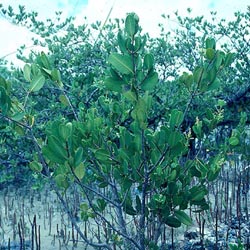Plant Profile: White Mangrove, Laguncularia racemosa
By Kelsey Cooper, Rebecah Horowitz, and Katie Kara
 |
| Fig. 1. L. racemosa - pneumatocysts & paddle- shaped leaves. Photo credit: T. Ann Williams. |
This post is one of a series from professor Nisse Goldberg's Botany students at Jacksonville University.
Classification
Kingdom: Plantae
Division: Magnoliophyta
Class: Magnoliopsida
Order: Myrtales
Family: Combretaceae
Genus: Laguncularia
Description
Laguncularia racemosa, or white mangrove, is a sprawling, woody shrub found in coastal habitats along West Africa, Northern South America, Mexico, the Caribbean Islands, and Florida. It can grow to be approximately 40 feet in height. In Florida, it is known to occur along the coast from Volusia County, around the southern tip of the state and northward on the Gulf side to Levy County. Laguncularia is a monotypic genus.
 |
| Figure 2. L. racemosa - flowers. Photo credit: Glenn Fleming. |
Although it tends to occur close to saltwater, this is not because it requires salt, but because it tolerates salt - an attribute which gives it a competitive edge over many other plants. L. racemosa can survive periods of inundation in part because of structures called pneumatocysts (figure 1) which provide its roots with access to oxygen.
 |
| Figure 3. L. racemosa - fruits. Photo credit: T. Ann Williams. |
The white mangrove is an important plant for numerous reasons. It serves as a windbreak along the coastline, its roots help slow erosion, and it provides birds, fish, and crustaceans with habitat for breeding, feeding, and nesting activities. Its wood is extremely durable and resistant to dry wood termites, but don't even consider cutting it down for this quality, as it is protected by the 1996 Mangrove Trimming and Preservation Act. Finally, its flowers are valuable to bees and apiculturists alike.
References
- Florida Forest Trees - White mangrove. (n.d.). The School of Forest Resources and Conservation. Retrieved April 9, 2012, from http://www.sfrc.ufl.edu/4h/white_mangrove/whitmang.htm.
- Holst, B. Guide to the Mangroves of Florida. Retrieved April 9, 2012, from http://www.scgov.net/sustainability/documents/NRBrochures/MangroveBrochure.pdf.
- Laguncularia racemosa. (n.d.). IUCN Red List maps. Retrieved April 9, 2012, from http://maps.iucnredlist.org/map.html?id=178798.
- McGaw, T. (2009). White Mangroves. Botany @ Suite 101. Retrieved April 9, 2012, from http://tamara-mcgaw.suite101.com/white-mangroves-a141247.
- What is a Mangrove? (2011, September 21). FDEP Office of Submerged Lands and Environmental Resources: Mangrove Coordination. Retrieved April 9, 2012, from http://www.dep.state.fl.us/water/wetlands/mangroves/mangrove_facts.htm.
- Wunderlin, R. P., and B. F. Hansen. 2008. Atlas of Florida Vascular Plants (http://www.plantatlas.usf.edu/). [S. M. Landry and K. N. Campbell (application development), Florida Center for Community Design and Research.] Institute for Systematic Botany, University of South Florida, Tampa.
Image Sources
Figure 1. http://florida.plantatlas.usf.edu/Photo.aspx?id=1154
Figure 2. http://florida.plantatlas.usf.edu/Photo.aspx?id=2654
Figure 3. http://florida.plantatlas.usf.edu/Photo.aspx?id=1153
Edited and posted by Laurie Sheldon



Comments